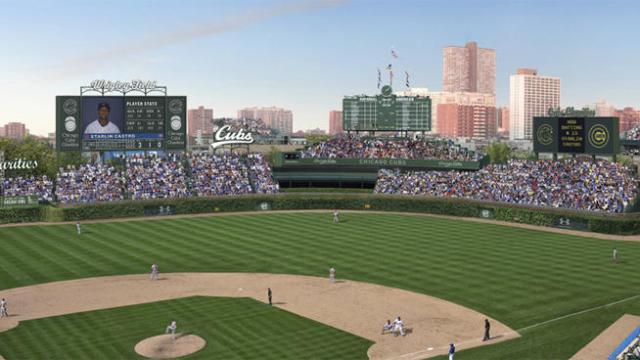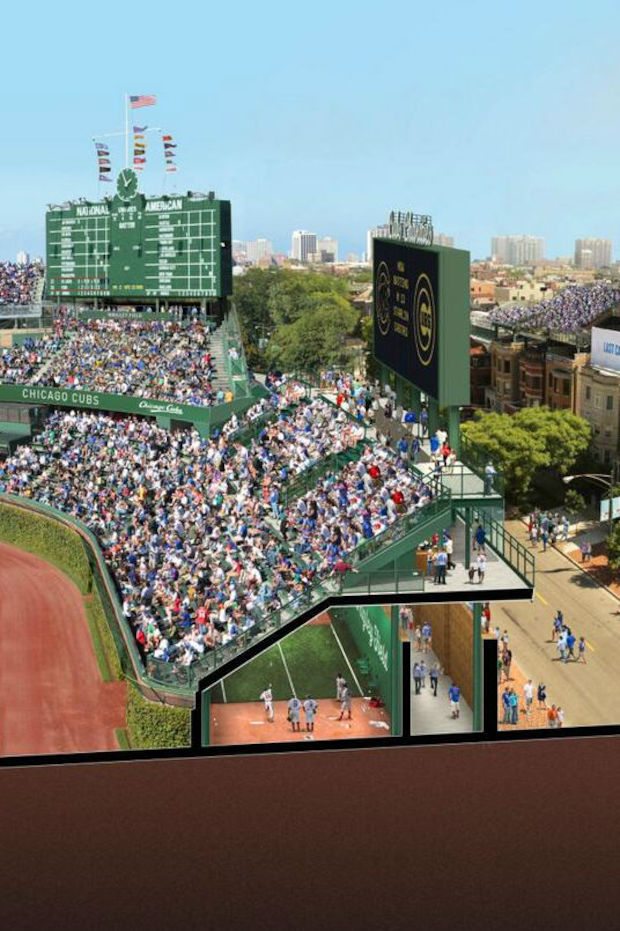Cubs Unveil Expanded Wrigley Field Renovation Plan
By Chuck Sudo in News on May 27, 2014 9:55PM

Image credit: Chicago Cubs
The Chicago Cubs unveiled their expanded plan to bring Wrigley Field kicking and screaming into the 21st century Tuesday afternoon, added more money to the plan and the ballclub even made the dreaded threat to move elsewhere if it could not “control our ballpark.”
As you can clearly see from the rendering above showing the new scoreboards and video screens in the revised plan, the Cubs are throwing figurative and literal shade in the direction of the rooftop clubs they blame for the impasse that led to their decision to move forward with the revised renovation plan, lawsuits be damned. The Cubs announced their revised renovation plan last week would include four additional 650 square-foot LED signs and a 2,400 square-foot video scoreboard in right field; 300 new seats; new outfield lights that would reduce shadows; moving the bullpens from their current spots against the grandstand walls to under the bleachers which would require removing bricks and ivy so pitchers can see the game; and expansions of both the Cubs and visitors clubhouses.
With the revised plan come revised costs; the new total is estimated to be around $575 million. Cubs president of business operations Crane Kenney, who helped get the ballclub in this mess in the first place by negotiating long-term revenue sharing contracts with the rooftops that still have a decade left before they expire, said they would look at other locations in Chicago if resistance to the renovation plan prevents them from moving forward.
“That would be what would happen, but those conversations have not occurred at any level. ... Everyone believes this project is moving forward. We’re all excited. The city, obviously, would love to see this move forward, as would the team and our fans. So, our focus has been 100 percent on Wrigley Field and moving this forward,” Kenney said.
The Cubs and the Emanuel administration worked in tandem to develop this revised plan, another sign they’ve run out of patience dealing with the rooftop clubs.

Image courtesy Chicago Cubs.
“You wouldn’t just drop this on the city without them seeing it. We started talking about, `What are the important dimensions from the city’s perspective that need to be maintained. That’s where we came up with ideas around 65 feet, shrinking down the video board [already approved in left-field], putting these signs in these spots and creating these envelopes,” (Kenney) said.
Kenney, in an attempt to further shift the public opinion against the rooftop owners, said the Cubs explored every option they had at their disposal to get the clubs on board including buying them out.
Sometimes you’d like to see this as a big dramatic gunfight at the O.K. Corral. It’s none of that. It’s simply a math problem. We need to generate revenue inside the ballpark. We’re financing this ourselves. We’re unlike every team building a new facility.”
The Wrigleyville Rooftops Association has already said they would take this to court.